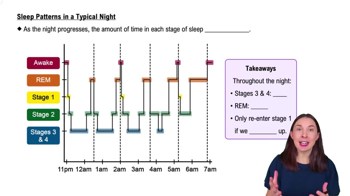Table of contents
- 1. Introduction to Psychology1h 43m
- 2. Psychology Research2h 20m
- 3. Biological Psychology2h 41m
- 4. Sensation and Perception28m
- 5. Consciousness and Sleep32m
- 6. Learning41m
- 7. Memory34m
- 8. Cognition37m
- 9. Emotion and Motivation35m
- 10. Developmental Psychology33m
- 11. Personality48m
- 12. Social Psychology41m
- 13. Stress and Health41m
- 14. Psychological Disorders44m
- 15. Treatment47m
5. Consciousness and Sleep
Sleep
Struggling with Psychology?
Join thousands of students who trust us to help them ace their exams!Watch the first videoMultiple Choice
Which of the following kills the most people in the United States every year?
A
Heroin overdose
B
Alcohol-related car accidents
C
Homicide
D
Illnesses related to smoking
 Verified step by step guidance
Verified step by step guidance1
Identify the key factors contributing to mortality rates in the United States, focusing on substance use, accidents, and health-related issues.
Research statistical data on the number of deaths caused by heroin overdoses, alcohol-related car accidents, and homicides annually in the United States.
Examine the impact of smoking-related illnesses, such as lung cancer, heart disease, and chronic obstructive pulmonary disease (COPD), on mortality rates.
Compare the mortality statistics of smoking-related illnesses with those of heroin overdoses, alcohol-related car accidents, and homicides to determine which is the leading cause of death.
Conclude that illnesses related to smoking result in the highest number of deaths annually in the United States, based on the comparative analysis of the data.

 3:25m
3:25mWatch next
Master Circadian Rhythms with a bite sized video explanation from Hannah Gordils
Start learningRelated Videos
Related Practice


































































































![Race, Genes and IQ Differences | Bret Weinstein [Mini Clip]](https://img.youtube.com/vi/IztL_m3pd70/mqdefault.jpg)



































































































